
Francisco José de Goya y Lucientes was a Spanish romantic painter and printmaker. He is considered the most important Spanish artist of the late 18th and early 19th centuries. His paintings, drawings, and engravings reflected contemporary historical upheavals and influenced important 19th- and 20th-century painters. Goya is often referred to as the last of the Old Masters and the first of the moderns.

The Naked Maja or The Nude Maja is an oil-on-canvas painting made around 1797–1800 by the Spanish artist Francisco de Goya, and is now in the Museo del Prado in Madrid. It portrays a nude woman reclining on a bed of pillows, and was probably commissioned by Manuel de Godoy, to hang in his private collection in a separate cabinet reserved for nude paintings. Goya created a pendant of the same woman identically posed, but clothed, known today as La maja vestida, also in the Prado, and usually hung next to La maja desnuda. The subject is identified as a maja or fashionable lower-class Madrid woman, based on her costume in La maja vestida.

The Countess of Chinchon is an oil-on-canvas portrait painted ca. 1800 by the Spanish artist Francisco Goya. It is held in the Museo del Prado, Madrid. The painting depicts María Teresa de Borbón, 15th Countess of Chinchón, who had been encouraged by Queen Maria Luisa of Parma and by opportunism to marry Manuel de Godoy, the Prime Minister, in a marriage of convenience. It does not depict the more famous Countess of Chinchón who became the namesake of the cinchona genus of trees and shrubs responsible for early modern quinine production.

Unfortunate Events in the Front Seats of the Ring of Madrid, and the Death of the Mayor of Torrejón is the name given to an etching with burnished aquatint, drypoint and burin on paper by the Spanish painter and printmaker Francisco Goya.

Atropos, or The Fates is one of the 14 Black Paintings painted by Francisco de Goya between 1819–1823. Goya, then 75 and in mental and physical despair, created the series directly onto the interior walls of the house known as the Quinta del Sordo, purchased in 1819.

Judith and Holofernes is the name given to one of the 14 Black Paintings painted by Francisco de Goya between 1819 and 1823. By this time, Goya was in his mid 70s and deeply disillusioned. In mental and physical despair, he painted the private works on the interior walls of his home—applying oils directly on plaster—known as the Quinta del Sordo, which he had purchased in 1819. Judith and Holofernes was likely painted on the first floor, beside Saturn Devouring His Son. The picture is a personal reinterpretation of the narrative of the Book of Judith, in which the protagonist saves Israel from the assault of the general Holofernes by seducing and beheading him. Judith is the only historical figure who can be identified with certainty among the Black Paintings.

A Pilgrimage to San Isidro is one of the Black Paintings painted by Francisco de Goya between 1819–23 on the interior walls of the house known as Quinta del Sordo that he purchased in 1819. It probably occupied a wall on the first floor of the house, opposite The Great He-Goat.

Two Old Ones Eating Soup or Two Witches is one of the fourteen Black Paintings created by Francisco Goya between 1819 and 1823. By this time, Goya was in his mid-70s and deeply disillusioned. He painted the works on the interior walls of the house known as the Quinta del Sordo. They were not intended for public display. Two Old Men Eating Soup likely occupied a position above the main door to the house, between La Leocadia and Two Old Men.

Two Old Men, also known as Two Monks or An Old Man and a Monk, are names given to one of the 14 Black Paintings painted by Francisco Goya between 1819-23. At the time Goya was in his mid-seventies and was undergoing a great amount of physical and mental stress after two bouts of an unidentified illness. The works were rendered directly onto the interior walls of the house known as Quinta del Sordo, which Goya purchased in 1819.

The Inquisition Tribunal, also known as The Court of the Inquisition or The Inquisition Scene, is a 46-by-73-centimetre oil-on-panel painting produced by the Spanish artist Francisco Goya between 1812 and 1819. The painting belongs to a series which also includes Bullfight, The Madhouse and A Procession of Flagellants, all reflecting customs which liberals objected to and wished were abandoned, but their reform was opposed by the absolutist (autocratic) policy of Ferdinand VII of Spain.

Los disparates, also known as Proverbios (Proverbs) or Sueños (Dreams), is a series of prints in etching and aquatint, with retouching in drypoint and engraving, created by Spanish painter and printmaker Francisco Goya between 1815 and 1823. Goya created the series while he lived in his house near Manzanares on the walls of which he painted the famous Black Paintings. When he left to France and moved in Bordeaux in 1824, he left these works in Madrid apparently incomplete. During Goya's lifetime, the series was not published because of the oppressive political climate and of the Inquisition.
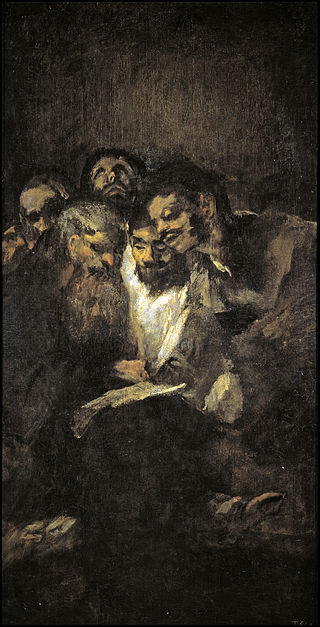
Men Reading or The Reading or Politicians are names given to a fresco painting likely completed between 1820 and 1823 by the Spanish artist Francisco Goya. It is one of Goya's 14 Black Paintings painted late in his life when, living alone in physical pain, spiritual torment and disillusionment with the political direction of Spain, he painted 14 bleak, agonised frescoes onto the walls of the Quinta del Sordo, the house he was living in alone outside Madrid.
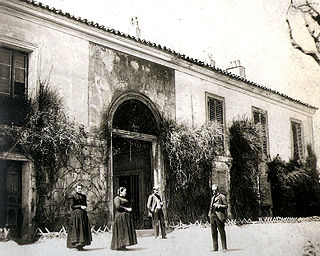
The Black Paintings is the name given to a group of 14 paintings by Francisco Goya from the later years of his life, likely between 1819 and 1823. They portray intense, haunting themes, reflective of both his fear of insanity and his bleak outlook on humanity. In 1819, at the age of 72, Goya moved into a two-story house outside Madrid that was called Quinta del Sordo. Although the house had been named after the previous owner, who was deaf, Goya too was nearly deaf at the time as a result of an unknown illness he had suffered when he was 46. The paintings originally were painted as murals on the walls of the house, later being "hacked off" the walls and attached to canvas by owner Baron Frédéric Émile d'Erlanger. They are now in the Museo del Prado in Madrid.

Portrait of Manuel Godoy is a large 1801 oil-on-canvas painting by the Spanish artist Francisco de Goya, now in the Real Academia de Bellas Artes de San Fernando. It was commissioned by the Spanish Prime Minister Manuel Godoy to commemorate his victory in the brief War of the Oranges against Portugal.

The White Duchess is a life sized oil-on-canvas painting by the Spanish artist Francisco Goya, completed in 1795. It portrays María Cayetana de Silva, 13th Duchess of Alba. It is in the collection of the House of Alba, in the Liria Palace, Madrid. It is one of a number of portraits Goya painted of the duchess around this time, and is usually compared alongside the similarly sized but tonally very different The Black Duchess, which was painted two years later, just after her husband, José Álvarez de Toledo died aged 39. The duke and duchess were highly placed, cultivated and well-regarded members of the 1790s Spanish Court.
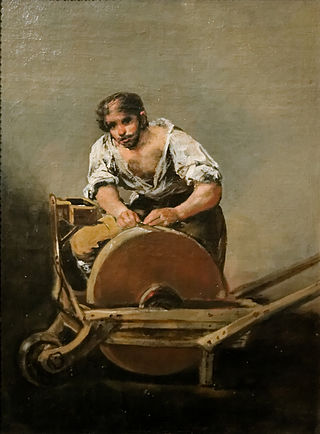
The Knifegrinder is an oil painting on canvas executed ca. 1808–1812 by the Spanish artist Francisco de Goya. It is now in the Museum of Fine Arts in Budapest.
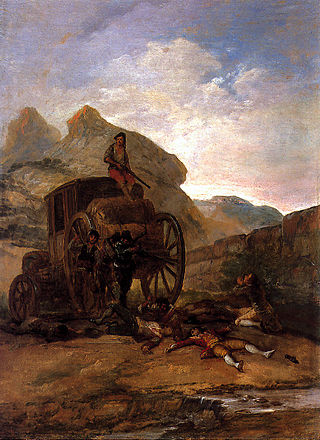
Assault of Thieves is an oil painting made by the Spanish artist Francisco de Goya between 1793 and 1794. It is part of a private collection owned by Juan Abelló.
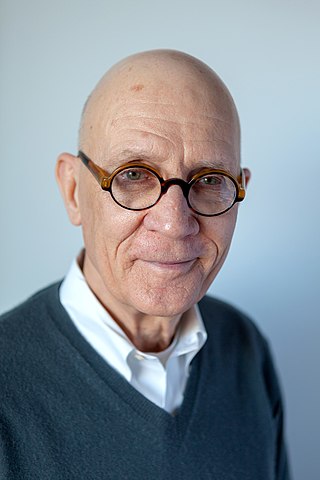
William Bryan Jordan Jr. was an American art historian who facilitated acquisitions, curated exhibitions, and authored publications on Spanish artists and still life paintings, particularly from the Golden Age.
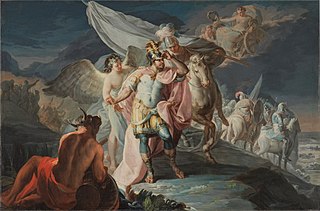
The Victorious Hannibal Seeing Italy from the Alps for the First Time, or Hannibal the victor crossing the Alps, or Hannibal the victorious from the heights of the Alps looks out over the plains of Italy is an oil painting by Spanish painter Francisco Goya, dating from his early years. It is the oldest documented work by the painter.



















